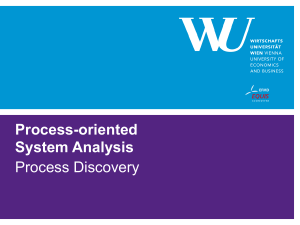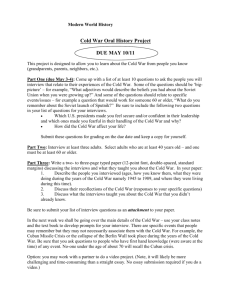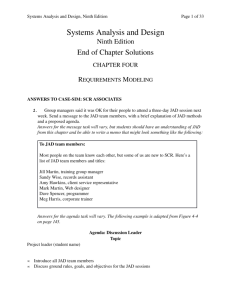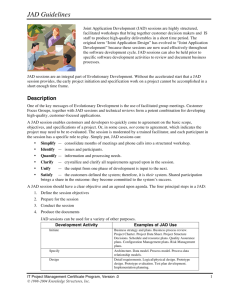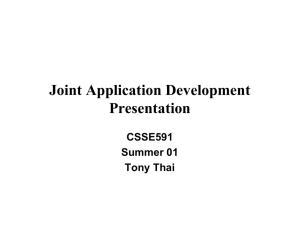StudyChk02 (see Study Guide)
advertisement
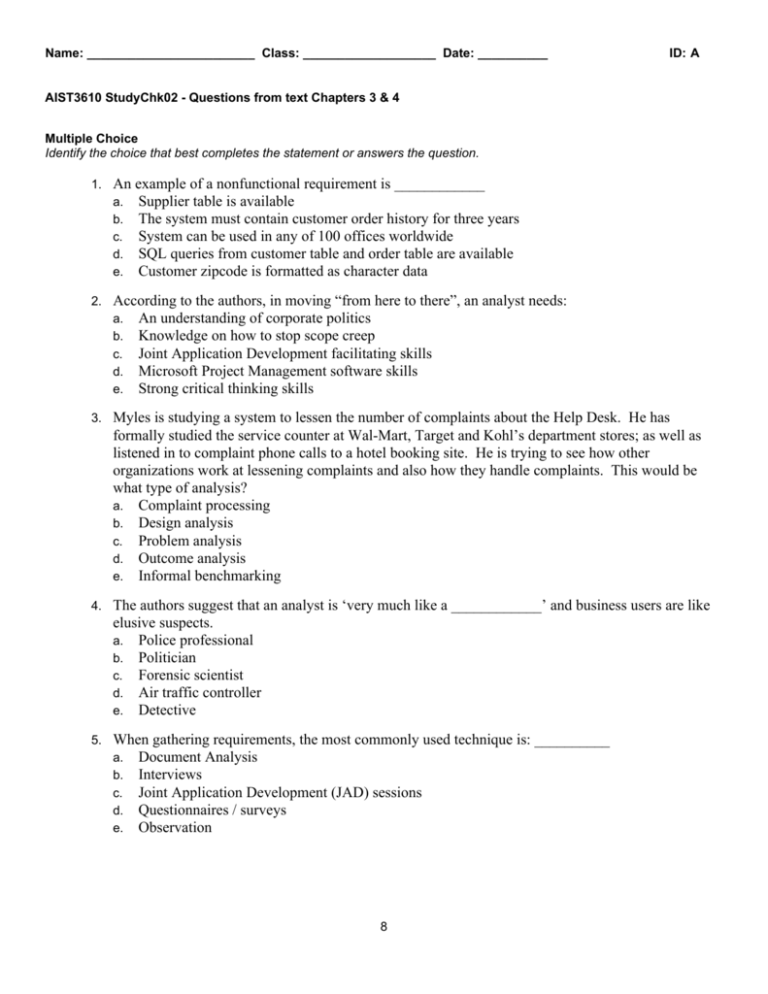
Name: ________________________ Class: ___________________ Date: __________ ID: A AIST3610 StudyChk02 - Questions from text Chapters 3 & 4 Multiple Choice Identify the choice that best completes the statement or answers the question. 1. An example of a nonfunctional requirement is ____________ a. Supplier table is available b. The system must contain customer order history for three years c. System can be used in any of 100 offices worldwide d. SQL queries from customer table and order table are available e. Customer zipcode is formatted as character data 2. According to the authors, in moving “from here to there”, an analyst needs: a. An understanding of corporate politics b. Knowledge on how to stop scope creep c. Joint Application Development facilitating skills d. Microsoft Project Management software skills e. Strong critical thinking skills 3. Myles is studying a system to lessen the number of complaints about the Help Desk. He has formally studied the service counter at Wal-Mart, Target and Kohl’s department stores; as well as listened in to complaint phone calls to a hotel booking site. He is trying to see how other organizations work at lessening complaints and also how they handle complaints. This would be what type of analysis? a. Complaint processing b. Design analysis c. Problem analysis d. Outcome analysis e. Informal benchmarking 4. The authors suggest that an analyst is ‘very much like a ____________’ and business users are like elusive suspects. a. Police professional b. Politician c. Forensic scientist d. Air traffic controller e. Detective 5. When gathering requirements, the most commonly used technique is: __________ a. Document Analysis b. Interviews c. Joint Application Development (JAD) sessions d. Questionnaires / surveys e. Observation 8 Name: ________________________ ID: A 6. A technique where a set of written (or online) questions are distributed to people (frequently to a large number of people) is: _____. a. Document Analysis b. Interviews c. Joint Application Development (JAD) sessions d. Questionnaires / surveys e. Observation 7. After creating the interview report you should: a. Send a copy to the interviewee with a request to read it and correct or clarify b. Change the document into a unchangeable format (like a pdf file) so that it cannot be changed or edited Distribute the interview report to all others that are on the interview schedule so they will not have to go over the same materials d. Edit the report into a bulleted format for easier analysis e. Distribute the interview report to the interviewee’s manager. c. 8. Probably the first thing to do when conducting an interview is: a. Turn on your tape recorder b. Get started by asking the first question on your list c. Build rapport with the interviewee so he or she trusts you d. Ask a close ended question e. Ask a probing question 9. Danielle has asked some closed ended questions to start an interview; then some open ended questions. Now she wants to really wants to get a greater depth of information about the process. She would probably use _________ questions. a. More closed ended b. More open ended c. Probing d. Structured e. Boxing structure 10. Michael, a systems analyst, is preparing a closed wiki site for Northstate Bank. He has written permission from eight other companies to view their internal wiki sites, and also has approval from his manager and the project team to use these other sites for ideas and structure. This would be a form of: a. Business Process Automation b. Business Process Improvement c. Informal Benchmarking d. Formal Benchmarking e. Technology Analysis 2 Name: ________________________ ID: A 11. An interview report is prepared in which step of the interview process? a. Conducting the interview b. Designing interview questions c. Post interview following-up d. Preparing for the interview e. Selecting an interviewee 12. Which of the following is true about a JAD facilitator? a. They can participate in the discussion to settle a disagreement b. They keep track of all discussions by entering information into the computer c. They allow sidebar discussions and unstructured activities d. They recognize that some people know more about the system and proposed system and will dominate the discussion and know that is a positive thing e. They set the meeting agenda 13. Hamid has selected one middle manager from each department that will be affected by the updated system and one lower-level manager from each department, along with a few senior staff as well as the project sponsor for a JAD session. He is trying to: _________ a. Balance the work load for departments so the regular day-to-day functions can still continue while the JAD team is off-site b. Create a new hybrid department that will beta test the final system c. Prevent domination by only a few individuals in the JAD session d. Have a broad mix of organizational levels in the JAD session e. Reduce the time necessary for the length of JAD session meetings 14. Marta wants to collect facts and opinions from a wide range of geographically dispersed people quickly and with the least expense. She would probably want to use: a. Document analysis b. Interview c. JAD session d. Observation e. Questionnaires 15. Blaine is using a requirements gathering technique that begins with non-threatening questions, avoids abbreviations, groups items into logically coherent sections, and might best be used with outside users. He probably is using: a. Document analysis b. Interview c. JAD session d. Observation e. Questionnaires 3 Name: ________________________ ID: A 16. Which is NOT true of use cases? a. They are formal ways of representing how a business system interacts with its b. c. d. e. environment They illustrates the activities that are performed by the users of the system They can be thought of as an external or functional view of a business process They illustrate what starts (or triggers) an event, all the people that are involved, and how the system provides value They sometimes are called ‘business scenarios’ (although ‘use case’ is generally preferred) 17. A ‘temporal’ trigger might be which of the following: a. A patient calls to make an appointment with a doctor b. The accounting department needs information for a report c. The human resources department needs a tax withholding form to be filled out by a new d. e. employee The date changes to the first day of the month A new shipping of goods arrives and needs to be added to the inventory 18. Which of the following is probably NOT a step for writing a use case? a. Identify the use case b. Identify the major steps within each use case c. Identify elements within steps d. Identify the analyst e. Confirm the use case 19. Omar is an analyst building a use case. Which of the following project roles might be the most important in terms of getting information about building the use case? a. Users b. Programmers c. Other analysts d. Project Sponsor e. Equipment vendors 20. Use cases are used to more fully delineate _____. a. Resources used in the system b. System boundaries c. System proposals d. System requirements e. Data flows 21. Barb is an analyst developing a use case. Which of the following will probably NOT be on her use case? a. Importance level b. Short Description c. Information for steps d. Destination for the major inputs e. Type of trigger 4 Name: ________________________ ID: A 22. A use case helps: a. Define interview questions b. Clarify ongoing costs for a system c. Identify risks with the project d. Refine project management milestones e. Understand system activities and requirements 23. Marta has asked the users of a system to picture themselves performing the processes and to write down those processes in a sequential order. She should get a good idea of ________. a. The major steps for each use case b. The use case c. The elements within steps d. The temporal triggers e. The external actors 24. Special cases (like customer cancels an appointment or returns an item) are: ____________ a. Frequently overlooked by users b. Described on special ‘exception’ use cases c. Not of importance at this stage d. Written as exceptions at the bottom of the relevant use case e. Given use case ID’s of “SC” (for special case) and a number 25. Use cases generally have three parts: _____. a. Basic information, details, and event-driven modeling b. Inputs and outputs, and events c. Details, event-driven modeling, basic information d. Technical feasibility, economic feasibility and organizational feasibility e. Basic information, inputs and outputs, and details 26. After working with Chris (who is a staff member in the registrar’s office) on major steps in the registration process, Maureen (a systems analyst) will: a. Discuss these steps with Thomas, the project manager b. Create data-entity maps c. Create use cases d. Create user interface screens e. Create narrative storyboards 27. As a last step in building a use case for the study-abroad registration system, Brianna will: a. Ask Patrick in the study abroad office to confirm the use case b. Ask Wendy in the registrar’s office to confirm the use case c. Ask Jonathan, a student who just completed a study-abroad experience, to confirm the d. e. use case Ask Drew in the students affairs office to confirm the use case Ask Taylor, another systems analyst to confirm the use case 28. The Major Inputs section on a use case will give the _____________ a. Sources of that input b. Destinations of that input c. Creator of that input d. User of that input e. What triggers the input to occur 5 Name: ________________________ ID: A 29. The Major Steps Performed section on a use case will give the _________ a. Name of the user for each step b. What triggers each step c. Where the processes will run (such as manual processes, client-server processes, etc.) d. The telecommunications infrastructure requirements for that step e. Information for each step 30. The second principal part of use cases is ‘input and output’. Another name might be: a. Origin and ending b. Data normalization c. Data flows d. Parallelism e. Program specifications True/False Indicate whether the statement is true or false. 31. One of the first activities of an analyst is to determine the business requirements for the new system 32. Some people have suggested that the ‘analysis’ phase could be clearer if it was called the ‘analysis and initial design’ phase. 33. Jorge, Vice President of Operations, has requested that the updated supply chain system keep a record of all ‘stock-outs’ for six years. This is an example of a functional requirement. 34. Maria, a systems analyst, is tweaking the high-level explanation of the business requirements into a more precise list of requirements. This is called ‘requirements detemination’. 35. Generally ‘system requirements’ are developed in the analysis phase and evolve to more technical ‘business requirements’ in the design phase. 36. In interviews, Ross has learned that the new order entry system must be available in at least three formats (mobile, web browser, and local area network based); that it must function in either English or Spanish; and that the system must return order forms and data in less than 2 seconds. He recognizes these as nonfunctional requirements. 37. The most important purpose of the requirements definition is to define the scope of the system. 38. To create the requirements definition, the project team first should consider the kinds of functional and non-functional requirements that they will collect about the system. 39. Management of requirements and system scope is one of the hardest parts of managing a project. 40. In RAD or agile development methodology (especially with BPR), a significant amount of time and effort is spent in understanding the as-is system. 6 Name: ________________________ ID: A 41. The requirements-gathering process is used for building financial support for the project and establishing common understanding of technologies and rapport between the project team building the system and the users of the system. 42. The most commonly used requirements gathering technique is the interview.. 43. Yuri wants to interview both managers and staff in the accounting department for the updated credit analysis project. This is an appropriate group for first round interviews. 44. Gary has eight interviews to conduct over the next week. Once he has completed all interviews, he should then write up a summary report. Preparing interview reports prior to completing all interviews will generally be premature until Gary has talked to all interviewees. 45. Rebecca, a fairly new employee in the company and Matt, her boss (who has been with the company for 22 years) are in your JAD session. It would probably be expected that Rebecca would not share much in the session. 46. Your company updated its processes for financial reporting when Sarbanes-Oxley became law. Additional changes in Sarbanes-Oxley reporting have been mandated to start in one year. To help you understand the as-is system, you should review the documentation, processes and procedures that were developed with the initial Sarbanes-Oxley project. 47. To get to more depth in understanding the as-is system, document analysis and observation generally are more beneficial as compared to interviews and JAD sessions. 48. Use Cases give more detail about requirements. 49. A Use Case is a formal way of representing how a business system interacts with its environment. 50. Use cases illustrate the activities that are performed by the users of the system. 51. Use cases are always internal and rarely shared or discussed with business users. 52. A use case depicts a set of activities performed to produce some output result. 53. Use cases are diagrams with three components: selection, process, iteration. 54. Use cases are a type of ‘event-driven modeling’. 55. Each use case has a name and a number. 56. Use cases are always numbered sequentially from start to finish. 57. The ‘primary actor’ is the external user that triggers the event to which the system responds. 58. A temporal trigger might be related to time, such as 30 days have passed and a late fee needs to be assessed. 7 Name: ________________________ ID: A 59. Use cases will have inputs and outputs. 60. The most common ways to gather information for use cases is with questionnaires of the affected users. Essay 61. Ralph is known throughout the company as being an old curmudgeon. But, he is without a doubt the most knowledgeable person in the fraud analysis department. The system project you are working on has to have an interface to various fraud applications. How should you prepare for an interview with Ralph? 62. The proposed TTR system makes some sweeping changes to how business is done. Upper management from the CEO / CIO down have encouraged this project. There is a team of 12 people working on various aspects of the project. You think the best solution is to have a JAD session of significant players on the project, but it is not going well. Several just cannot get away from other projects and responsibilities. How should you approach this? 63. During an interview, the interviewee expresses a strong opinion on a topic, like “SOA will not work here”. What should you do? How would you approach this? 64. Your project sponsor has suggested several key people to involved in a JAD session. You cannot include all of the people, so you pick and choose those to invite to the session. You hear from the informal grapevine that one person that was not invited is upset and feels left out. This person has been with the company for 12 years and had a lot of expertise. What should you do? Why? 65. Vanessa is a manager in the department that has requested an updated system. Chad is the systems analyst who has been working with Vanessa on the project. He interviewed her (and others in her department); he developed a set of requirements for the project; he has created use cases for the project. What might be Vanessa’s duty now that Chad has created the use cases? 8


